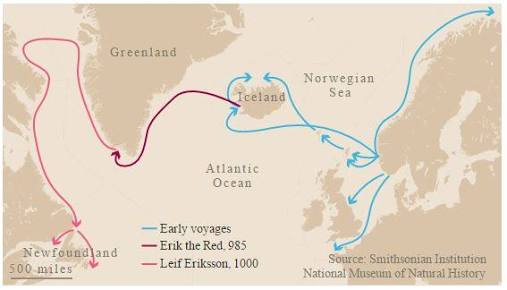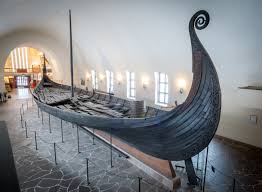.jpg)
THE WIND WHISTLING THROUGH THE RIGGING HAD TO BE A WIND FROM THE GODS.
It was freakish, blowing Eric the Red ever westward further into exile. For days now, he had been sailing into the unknown and had given up hope of seeing land again when he saw the mass of Greenland heave into sight over the horizon.
.jpg)
The story of that first sighting of Greenland, in the 10th century, is a typical Icelandic folk memory, as is its subsequent colonisation by a hero cast out on stormy seas. The true heroism of the Vikings was their willingness to follow the winds and currents using 'environmental navigation', which combined their observations of the Sun, the stars, the winds and the sea swell- to set their courses. When they approached land, they read the cloudscape or followed the flight of homing birds- like the legendary discoveries of Iceland in the 9th century, who released ravens at regular intervals and followed them to land.
Ships built of oak and iron
.jpg)
Inherited wisdom and personal experience also steered the settlers who followed Leif Ericsson, Eric the Red's son, to Newfoundland in the early 11th century. The settlers' ships were not the slinky serpent ships used by Vikings raiders, nor the gold-mouthed, splendid beasts of the mast' celebrated in song by Norse poets, but broad, deep vessels similar to those unearthed by archaeologists at Skuldelev, Denmark, in 1962.

These ships were about 50 ft long and 15 ft wide. Their overlapping planking of pine, or sometimes ask or oak, was made watertight with a caulking of animal hair soaked in pine tar and then fastened with iron rivets. The keel, stems and ribs of the boat were made from oak, witg the ribs fastened to the planking by wooden nails and willow.
The central mast had a square sail of coarse woollen cloth which was at its most efficient in a following wind. The ships were steered by a rudder which fitted over the starboard side of the boat, towards the stern, and three or four oars kept in the front of the boat were used to maneuvre the vessel in confined spaces. Although there were decks at the bow and stern of the boats, the hold in the center was left open to the sky and held cargo and livestock.
Stores- salted provisions, sour milk and beer were also stowed amidships in skins or casks which were almost impossible to keep dry. No cooking could be done on board, but all the ships were provided with huge cauldrons for use on shore whenever possible.
To navigate without intruments into unknown regions thick with icebergs seems a strange undertaking, but the Vikings' reasons for going sound familiar. According to a Norwegian book of 1240: 'One motive is fame, another curiosity and third is lust for gain.'
